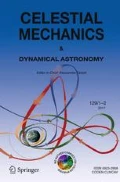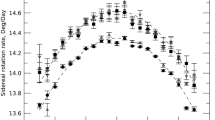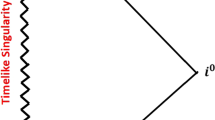Abstract
We investigate the resonant rotation of co-orbital bodies in eccentric and planar orbits. We develop a simple analytical model to study the impact of the eccentricity and orbital perturbations on the spin dynamics. This model is relevant in the entire domain of horseshoe and tadpole orbit, for moderate eccentricities. We show that there are three different families of spin–orbit resonances, one depending on the eccentricity, one depending on the orbital libration frequency, and another depending on the pericenter’s dynamics. We can estimate the width and the location of the different resonant islands in the phase space, predicting which are the more likely to capture the spin of the rotating body. In some regions of the phase space the resonant islands may overlap, giving rise to chaotic rotation.











Similar content being viewed by others
Notes
the coordinates of the other point are \((5\pi /3,0)\). The permutation of the index 1 and 2 of the planets allows to exchange the two equilateral configurations, which are linearly stable for small enough planetary masses (namely, if \(\frac{m_0 m_1+m_1 m_2+m_0 m_2}{(m_0+m_1+m_2)^2} < \frac{1}{27} \approx 0.037\), see Gascheau 1843).
Note that since \(\xi _l\) depends only on \(\zeta _0\), the coefficients \(K_q\) depend only on the product \(p\delta \) instead of p and \(\delta \).
References
Charlier, C.V.L.: Über den Planeten 1906 TG. Astron. Nachr. 171, 213 (1906)
Chirikov, B.V.: A universal instability of many-dimensional oscillator systems. Phys. Rep. 52, 263–379 (1979)
Colombo, G.: Rotational period of the planet mercury. Nature 208, 575 (1965)
Correia, A.C.M.: Secular evolution of a satellite by tidal effect: application to triton. Astrophys. J. Lett. 704, L1–L4 (2009)
Correia, A.C.M., Laskar, J.: Mercury’s capture into the 3/2 spin–orbit resonance including the effect of core–mantle friction. Icarus 201, 1–11 (2009)
Correia, A.C.M., Robutel, P.: Spin–orbit coupling and chaotic rotation for coorbital bodies in quasi-circular orbits. Astrophys. J. 779, 20 (2013)
Correia, A.C.M., Rodríguez, A.: On the equilibrium figure of close-in planets and satellites. Astrophys. J. 767, 128 (2013)
Danby, J.M.A.: Stability of the triangular points in the elliptic restricted problem of three bodies. Astron. Astrophys. 69, 165 (1964)
Dermott, S.F., Murray, C.D.: The dynamics of tadpole and horseshoe orbits. I—theory. Icarus 48, 1–11 (1981)
Gascheau, G.: Examen d’une classe d’quations diffrentielles et application un cas particulier du problme des trois corps. Comptes Rendus 16, 393 (1843)
Giuppone, C.A., Beaugé, C., Michtchenko, T.A., Ferraz-Mello, S.: Dynamics of two planets in co-orbital motion. Mon. Not. R Astron. Soc. 407, 390–398 (2010)
Goldreich, P., Peale, S.: Spin–orbit coupling in the solar system. Astron. J. 71, 425 (1966)
Hansen, P.A.: Entwickelung der products einer potenz des radius vectors mit dem sinus oder cosinus eines vielfachen der wahren anomalie in reihen. Abhandl. d. K. S. Ges. d, Wissensch, IV. 182281 (1855)
Lagrange: Œuvres complètes, vol. VI, p. 272. Gouthier-Villars, Paris (1772/1869)
Laskar, J.: Frequency analysis of a dynamical system. Celest. Mech. Dyn. Astron. 56, 191–196 (1993)
Leleu, A., Robutel, P., Correia, A.C.M.: Detectability of quasi-circular co-orbital planets. Application to the radial velocity technique. Astron. Astrophys. 581, A128 (2015)
MacDonald, G.J.F.: Tidal friction. Rev. Geophys. Space Phys. 2, 467–541 (1964)
Mikkola, S., Innanen, K., Wiegert, P., Connors, M., Brasser, R.: Stability limits for the quasi-satellite orbit. Mon. Not. R. Astron. Soc. 369, 15–24 (2006)
Morais, M.H.M.: A secular theory for trojan-type motion. Astron. Astrophys. 350, 318–326 (1999)
Morais, M.H.M., Namouni, F.: Asteroids in retrograde resonance with Jupiter and Saturn. Mon. Not. R. Astron. Soc. 436, L30–L34 (2013)
Morbidelli, A.: Modern celestial mechanics: aspects of solar system dynamics. Taylor & Francis, London (2002)
Murray, C.D., Dermott, S.F.: Solar system dynamics. Cambridge University Press, Cambridge (1999)
Namouni, F.: Secular interactions of coorbiting objects. Icarus 137, 293–314 (1999)
Nauenberg, M.: Stability and eccentricity for two planets in a 1:1 resonance, and their possible occurrence in extrasolar planetary systems. Astron. J. 124, 2332–2338 (2002)
Robutel, P., Laskar, J.: Frequency map and global dynamics in the solar system I: short period dynamics of massless particles. Icarus 152, 4–28 (2001)
Robutel, P., Niederman, L., Pousse, A.: Rigorous treatment of the averaging process for co-orbital motions in the planetary problem. ArXiv e-prints (2015)
Robutel, P., Pousse, A.: On the co-orbital motion of two planets in quasi-circular orbits. Celest. Mech. Dyn. Astron. 117, 17–40 (2013)
Robutel, P., Rambaux, N., El Moutamid, M.: Influence of the coorbital resonance on the rotation of the trojan satellites of saturn. Celest. Mech. Dyn. Astron. 113(1), 1–22 (2012)
Wisdom, J., Peale, S.J., Mignard, F.: The chaotic rotation of Hyperion. Icarus 58, 137–152 (1984a)
Wisdom, J., Peale, S.J., Mignard, F.: The chaotic rotation of Hyperion. Icarus 58, 137–152 (1984b)
Wolf, M.: Photographische Aufnahmen von kleinen Planeten. Astron. Nachr. 170, 353 (1906)
Author information
Authors and Affiliations
Corresponding author
Appendix
Appendix
Rights and permissions
About this article
Cite this article
Leleu, A., Robutel, P. & Correia, A.C.M. On the rotation of co-orbital bodies in eccentric orbits. Celest Mech Dyn Astr 125, 223–246 (2016). https://doi.org/10.1007/s10569-016-9681-4
Received:
Revised:
Accepted:
Published:
Issue Date:
DOI: https://doi.org/10.1007/s10569-016-9681-4




